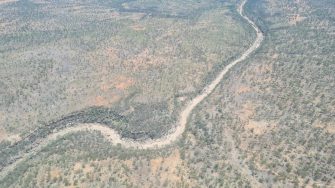
Date: Wednesday, November 4, 2020
Project: Eastern Australian Waterbird Survey
Observers: Richard Kingsford UNSW, John Porter UNSW/DPIE
Pilot: James Barkell NSW National Parks & Wildlife Service (DPIE)
We left Shute Harbour and headed west to Mt Isa. This was always going to be a very hot day. With temperatures predicted to reach 42 oC in MT Isa, the earlier we got away the better. We headed to survey Proserpine Dam first. This had thousands of hardhead and hundreds of coot, black duck and glossy ibis. It had dried back quite a bit and the shallow exposed margins obviously provided good habitat for lots of waterbirds.
We then headed over the Great Dividing Range, past the town of Collinsville and its nearby coal mines.
Just west of here, before we started on the Burdekin River, there were just a few farm dams that had dried back considerably. These did not have many waterbirds.
We then surveyed down the Bowen River which runs into the Burdekin River. This is a lovely sand river which often has a few jabirus or black-necked storks. We only saw one today. Otherwise there were only a few black duck and egrets.
And then on to the Burdekin. This is an incredibly picturesque river, with rocks of various hues of red, contrasting the green vegetation along its banks. But as usual it did not have many waterbirds - just the odd egret and heron. And I spotted one dead estuarine crocodile on its back.
The next major wetland was the massive Burdekin Dam or Lake Dalrymple which regulates flows in the Burdekin River. As usual it had very few waterbirds – mainly a few flocks of cormorants and wood ducks feeding on the drying back green areas around the shoreline.
We then made our way over the White Mountains and the top of the Flinders River, north of Hughenden where we refuelled and had lunch.
Afterwards, we took off in the oppressive heat and headed to Mt Isa. There were very few wetlands with water on this leg, except for a few waterholes which were drying back considerably.
Finally, we made it to Mt Isa, where we surveyed Lake Moondara, a large dam north of the town. This extensive area of water is always great for waterbirds. It had thousands but probably not the tens of thousands we sometimes see. There was a very high diversity as usual. These included jacanas, green pygmy-geese and lots of the duck species, including wandering whistling-ducks and hardhead. There were also lots of fish-eating birds. Once we had done the survey, we were landed in hot Mt Isa where the heat wave continued into early evening.
Blog by Richard Kingsford
